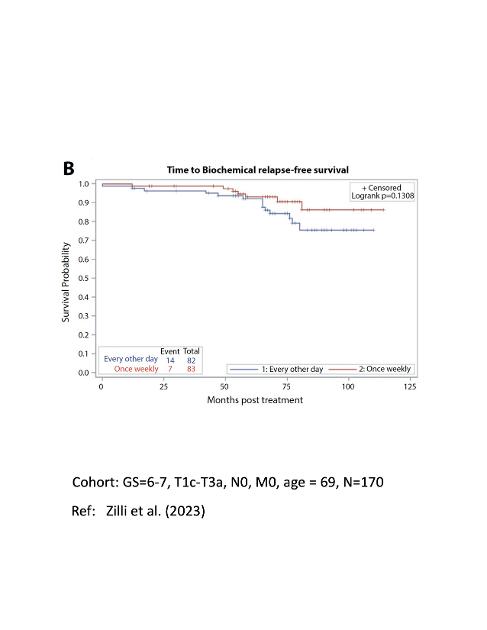Yes, according to a recent randomized, five-year Phase-III study by Zilli et al. (2023). Doing SBRT Once-a-Week significantly outperforms doing it Every-Other-Day (EOD), in terms of risk of having Biochemical Recurrence at 10 years.
Is SBRT given Once a Week better than... - Prostate Cancer N...
Is SBRT given Once a Week better than Every Other Day?

It does not say what you are posting. I know you don't understand statistics, but p values greater than 0.05 (it was 0.13) means that one must reject the null hypothesis of an unfavorable response rate. The null hypothesis in this case is that once a week is worse than every other day. So it means that so far, once-a-week is not worse than every-other-day, not that it "outperforms" it, as you wrongly wrote.
Why do peer reviewed papers publish graphs like this, if they have no meaning?
They are written for fellow doctors who have a background in statistics and research methods. They are very meaningful. That was an "inferiority trial" and the curve so far proves that the new treatment schedule is not inferior. They are not written for patients like you who are completely ignorant about how to read them. If you want to understand how to read them, take at least a Statistics 101 course.
What you posted is called a Kaplan-Meier curve. When you draw a conclusion that is opposite to the conclusion drawn by the author, assume you are wrong. The editors and peer-reviewers wouldn't make that kind of mistake.
The choice between delivering SBRT (Stereotactic Body Radiotherapy) once a week versus every other day depends on various factors, including the tumor type, size, location, patient's overall health, and treatment goals.
**Key considerations include:**
1. **Biological Effectiveness**:
- **Every Other Day**: SBRT every other day allows for a shorter overall treatment time. This can be beneficial as it may prevent tumor repopulation between treatments. Frequent dosing can also maintain the cumulative biological dose, potentially enhancing the treatment's effectiveness against rapidly proliferating tumors.
- **Once a Week**: This regimen spreads out the treatment, possibly reducing acute toxicity and allowing normal tissues more time to recover between doses. This might be advantageous for patients with comorbidities or when normal tissue tolerance is a concern.
2. **Patient Convenience and Compliance**:
- **Every Other Day**: This schedule might be more demanding for patients in terms of frequent visits, which can be challenging for those with logistical or mobility issues.
- **Once a Week**: This is more convenient and less physically taxing for patients, potentially improving compliance and quality of life during treatment.
3. **Toxicity and Side Effects**:
- **Every Other Day**: There is a risk of increased acute side effects due to the higher frequency of treatment, although this approach might help with better local control in some cases.
- **Once a Week**: The lower frequency might reduce acute toxicity, making the treatment more tolerable, especially in sensitive areas.
**Clinical Evidence**: There isn't a one-size-fits-all answer, and clinical evidence can vary based on specific cancer types and patient populations. Some studies suggest that spacing out treatments could potentially reduce side effects without compromising efficacy, while others indicate that more frequent dosing may offer better tumor control.
Ultimately, the best approach should be individualized based on the specific clinical scenario. Discussing with a radiation oncologist who is familiar with the latest research and your particular case is crucial in determining the most appropriate regimen.